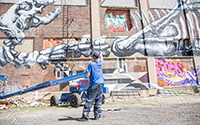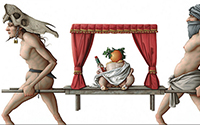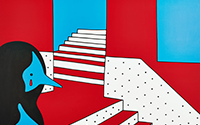
In the Face of Violence, a Mexican Artist Finds Sanity in Stereotypes
By Julie Schwietert Collazo
Photos by Francisco Collazo

When Mexico City artist Edgar Flores, aka Saner, started talking with New York City’s Jonathan LeVine Gallery about his first solo show with the space, the 43 students in the rural town of Ayotzinapa, Mexico, who would be kidnapped and disappeared by military and police in late September 2014, were still going about their daily lives. Mexicans around the country hadn’t yet taken to the streets for months of protests. The Mexican attorney general hadn’t yet held a press conference in which he would report that the students had been thrown on a burning pyre and incinerated beyond even forensic recognition. And an intrepid young man named Adán Cortés hadn’t yet tried to draw international attention to the disappearances by interrupting the Nobel Peace Prize ceremony, running towards the winners with the Mexican flag and begging youth activist Malala Yousafzai to talk about what was happening to young people in Mexico.
Nevertheless, for anyone who is familiar with the story about the disappeared students, a twisting (and twisted) tale involving state complicity that has gripped the entire country, the more than 30 works in Primitivo (Spanish for “primitive”) will seem eerily prescient and relevant, as will the name and theme of the exhibition and the philosophy informing it.
“It’s called ‘Primitivo’ because in this ‘sophisticated’ world we live in, we believe that we’re people who have achieved so much, that we’ve invented so much in the realm of technology, that we live such stable and comfortable lives,” Saner told me during a walk-through preview of the show the day before it opened to the public. “But in certain moments, we behave a lot like primitive people. If we look at a number of situations around the world, it seems that we’re more primitive than ever. We have no problem flattening other people in our own pursuit of what we want.”
These are the ideas that Saner, who started his career as a street artist, engages in Primitivo. The works draw on imagery from ancient indigenous Mexican cultures: there’s a wolf mask over the face of a man dressed in a contemporary suit, a cheetah mask hiding the face of a mariachi in full dress, and jade and wooden masks obscuring the faces of lovers locked in an embrace. The identities of burly-bodied cartel members with coarse, powerful hands are protected by animal masks, and the image of the wolf in sheep’s clothing, a recurring symbol in Saner’s work, makes an appearance in the series as well. But the notion of the “primitive” is applied in another sense, too, one that Saner hopes will give viewers of his work reason to pause.
“We often use the word ‘primitive’ to talk about our baser behaviors and impulses, our raw instincts,” he said, “But I’m also exploring the idea of ‘primitive’ here by acknowledging that so-called primitive people often had a much more sophisticated, profound relationship with the world than we do. They respected the world in which they lived more than we do. They realized that they couldn’t be sewing and reaping simultaneously. It would help us to remember that, to recall that we’re part of a longer, larger past. The symbols in these pieces — the jade, the feathers, the masks — aren’t just about obscuring; they’re about recalling that living in harmony with our surroundings is possible, that it’s something to aspire to.”
Only a couple weeks passed between Saner’s initial talks with the gallery and the devastating events in Ayotzinapa. As the complicated narrative of the kidnapping unfolded and the role of the state in the students’ disappearance became clearer, the symbolism of the theme and motifs visible in the works in Primitivo gained greater power, and Saner began conceptualizing a few additional pieces specifically about the missing students to include in the show. “I’m not a demonstrator in the streets,” he said, referring to thousands of Mexicans who have participated in peaceful protests around the country since the students’ disappearances. “What I have is my pen and my brush.”

Saner’s work has always had political and social elements, even when he was a young street artist. And it wasn’t only in his colorful murals where the ideas he continues to explore today were evident. “My first street art name was SPIC,” he said, explaining that he has played with and contested the ways in which people see and name one another throughout his career. SPIC was a reappropriation of the derogatory term “’spic,” short for “Hispanic,” that was used more commonly in the early 1990s than it is now. Over time, he changed his street tag to Saner, saying that the new name reflected his growing interest in the labels of and relationship between the concepts of “sane” and “crazy.”
As his work has evolved and his profile has become more visible, however, Saner has been confronted with many of the same questions about power and progress that his art — now mainly on paper and canvas — tends to tackle. He is acutely aware, for example, that exhibiting his work in a New York City gallery to deep-pocketed buyers who likely know little, if anything, about contemporary Mexican politics and society, could be considered selling out. At the same time, he points to the fact that the grand Mexican muralists like Diego Rivera, who are often considered (especially by outsiders) as highly political, were often in the employ of the state and charged with the task of painting works that enshrined a certain version of history. The challenge of staying true to the spirit of street art while stepping into the rarefied world of the art gallery — a New York art gallery in particular — is one he is learning to negotiate as he goes along, he says. And while the imagery of the pieces in Primitivo is undeniably Mexican in origin and references Mexican history and current events, Saner contends that the viewer doesn’t necessarily need to have reference points from Mexican culture to “get” the work or its message. The idea of the primitive and the impulse to hide behind masks, whether out of discomfort or malice, is one that’s universal, he says.






